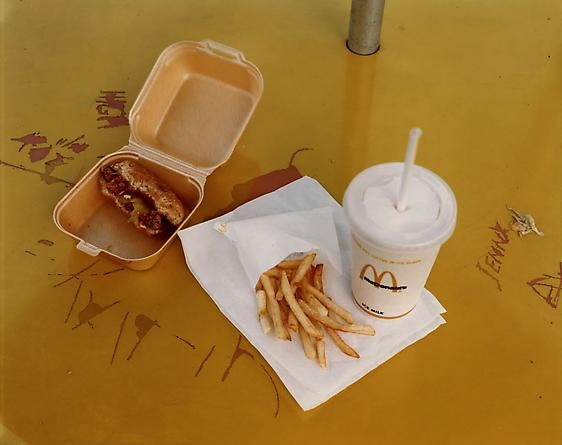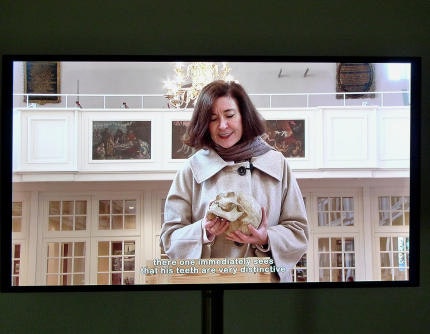If Images Could Speak
In a recent contribution to the collection Documentary Across Disciplines, based on a series of events held at the Haus der Kulturen der Welt in Berlin between 2010 and 2014, Christopher Pinney begins his essay, entitled “Bruises and Blushes: Photography ‘Beyond’ Anthropology”, with a quotation from Barthes’ Camera Lucida: “Society is concerned to tame the Photograph, to temper the madness which keeps threatening to explode in the face of whoever looks at it”. For Pinney, it is the division between “two ways of the Photograph” – between subjecting it to “the civilized code of perfect illusion” and confronting its “wakening of intractable reality”, as Barthes puts it – which challenges anthropology, “whose history is broadly parallel to that of photography”, to rethink its ‘realist’, ‘representational’ conception of the documentary image as “a vitrine filled with illustrative evidence, seemingly inert”, and instead to open itself to “photography’s ‘disturbance’”. 1Christopher Pinney, “Bruises and Blushes: Photography ‘Beyond’ Anthropology”, in Erika Balsom and Hila Peleg (eds.), Documentary Across Disciplines (Cambridge, MA: MIT Press, 2016), 21–23.
In positing a new conception of the documentary image in the context of anthropology, the privileged reference point here is Latour – in criticising Bourdieu’s ethnographic studies of photography, Pinney refers to the latter as “exemplary of what we might think of as pre-Latourian anthropology”. Yet it also indicates, as such, some of the dilemmas thrown up by this straightforward valorisation of the “contingent” and “unexpected”, and of the “productivity” of an “un-nameability”, as an access to a “language of things”. For while this may certainly challenge the “epistemic privilege” and violence, as Hito Steyerl calls it, of a certain documentary mode, it also risks simply replacing social and historical explanation altogether in favour of a sheer aesthetic descriptiveness, as that alone which would allow ‘us’ access to the thing’s alien “intractable, unruly reality”. Pinney’s concluding account of Leviathan is somewhat exemplary:
“A fish head perches on a gunnel before it is washed into the ocean. The light refraction makes every surface of the industrial carnage as beautiful and enchanted as the embarrassment of riches on display in a painting by Willem Kalf or Pieter Claesz. We see skate wings hacked off and the bilge water flowing red with blood as though a Pollock drip painting had been taken to its ultimate liquid potential, torrents of blood pouring onto a canvas of aquamarine and turquoise flecked with planktonic psychedelia”. 2Ibid, 36.
One might wonder whether, as it is presented here, such aestheticisation and “enchantment” of “industrial carnage”, much as it may liberate us from 'representation' and 'illustration', is really quite so easily to be celebrated (by contrast to, say, the social 'understanding', however qualified, offered by a 'realist' documentary work like Allan Sekula’s Fish Story).
If this returns us to the ways in which “images register the world”, as Ian Bogost puts it in his object-oriented ontological ‘reading’ of Stephen Shore’s photographs, the world so registered, free of what Bogost calls the “usual focus of human activity”, is, similarly, a fundamentally aesthetic one. While this may suggest a kind of democratizing of the image as a translation of the “language of things” in which “[n]othing is overlooked, nothing reduced to anything else, nothing given priority”, refusing “to treat any object as primary, as a subject”, its result is a profound unmooring of the thing-like “detail” from any attempt to grasp the various social, economic or technological structures within which such “things” acquire a meaning as anything other than aesthetic:
Clearly this is not what someone like Steyerl envisages when she seeks to outline a different politics of the (documentary) image as a form of translation, in the ways in which I sought to outline in my previous post. Indeed, her focus on the traumatic image – or, perhaps better, the traumatised image – which is, on her own terms, less concerned with trauma as a “content” of the image than it is with the ways in which violence and trauma are indexed in the image’s “form”, suggests a very different understanding of how “images register the world”, even if she shares with Pinney and Bogost a desire to escape the 'abstractions' of representation and the 'realist paradigm'. In fact, it is, above all, the status of the image as forensic witness that seems to most consistently concern Steyerl in her various writings since “A Thing Like You and Me”, and which underpins her attempt to outline a rethinking of documentary “truth” as “neither in the represented nor in the representation”, but “in its material configuration”.
Exemplary in this regard is her excellent and moving essay “Missing People” that starts out from the status of the disappearance (and presumed murder) of more than 100,000 people under General Franco in the context of new attempts to bring legal charges of crimes against humanity, and the role played by different “objects of evidence” within this. As she writes, drawing on Leibniz, as things that “store information”, “bones, skulls and other objects of evidence” are like “monads” in that they “condense not only their own history, but – in an opaque and unresolved form – everything else as well. They are like hard disks that fossilize not only their own history, but the history of their relations to the world”.
Or, they are like photographs. “The strata of crystallized time in each monad”, Steyerl continues, “capture a specific relation to the universe and conserve it, as in a long exposure photograph. In this way, we can understand a bone as a monad – or more simply, as an image”. As I suggested in my previous posts, the image-as-fossil evidently appeals itself as an image here to the extent that it invokes what appears to be a distinctively non-human ‘sign’ – a ‘sign’ in which, indexically, a certain nature 'speaks' of its own accord – that pre-exists ‘us’ yet which calls to ‘us’ to be deciphered or translated. In this, if the language of things is, perhaps inevitably, directed to ‘us’ (and hence invites ventriloquism on its behalf), it is also somehow before and outside of ‘us’, the inhuman and quasi-autonomous language of “a world without me, that is, a world viewed as though in the absence of the viewer”, as Stanley Cavell describes the cinematic image. 4Cited in Fredric Jameson, The Antinomies of Realism (London: Verso, 2013), 169. (Although it should also be noted that, in returning to the theological premises of Benjamin’s 1916 essay, if the human capacity "to decipher some layers of monads" is necessarily limited, it is because only God, for Leibniz himself, is "able to read all monads". And as"‘the only being able to read them, God is in all things.") In this sense at least, images are “mediations between the world and human beings”, as Flusser puts it, in a way that cannot be captured by the conventional concept of ‘representation’. 5Vilém Flusser, Towards a Philosophy of Photography (London: Reaktion, 2000), 9.
Steyerl’s argument evidently concurs in several respects with someone like Pinney’s distinction between “two ways of the Photograph” – between that which subjects the thing to “the civilized code of perfect illusion” and that which engages a disturbing “wakening of intractable reality”. (Steyerl references, albeit ambiguously, Dziga Vertov’s “pulsating symphony of matter” in The Man With A Movie Camera as that which resists the documentary treatment of things as objects, “as evidence for human plots”, or a complicity in “creating power/knowledge”.) Nonetheless, a conception of things that “staunchly remain things, refusing to be identifiable in the register of human beings” is also not, I think, unproblematic, in either philosophical or political terms. First of all, as Svenja Bromberg has pointed out, there is, to put it bluntly, a danger of political complacency in suggesting that embracing objectification might itself somehow displace “the classed, racialised and gendered oppressions of capitalist reality”, as if even to talk about the subjectivation of those “masses of people [that] have never been granted any ‘subject status’ in the first place and are, instead, rendered mere objects or even superfluous” would be to submit to some violence of 'representation'.
Perhaps the most affecting example of this offered by Steyerl is in her “Missing People” essay where she recounts the “charred photo roll” that she found on the site of a mass grave in Turkey that probably contains the remains of her friend Andrea Wolf, and which “may be the only witness to what happened during the battle that took place there in late 1998”. As an “illegible image”, the burnt 35 mm roll is exemplary of the “poor image”, since, unreadable as a photographic image in any conventional sense, it is rather the roll as material thing that becomes the index, showing “what happened to itself as it went up in flames, doused with unknown chemicals, incinerated along with the photographers’ dead body”. So, in this instance, does the thing 'speak' of 'itself'.
Yet, as I indicated in my first post, to the degree that the indexical character of this comparison of the thing to “a fossil in which a constellation of forces are petrified” remains obvious – and, consequently, allows for the deciphering of the image’s “bruises” and imprints of violence in such a way that things “are made to speak” – the materialism that is affirmed here is actually more complex than Steyerl herself seems to acknowledge. For if, on the one hand, there is indeed something distinctive about the image qua image, it is hard to see how one can sustain the idea that the image is also just a thing “like any other”, to the extent that it must surely be defined in this case, inescapably, by some intrinsic doubleness, as at once a thing and as imprinted (most often, violently) with the trace of another thing or things. On the other hand, if one argues that, as material configuration, all things are images, insofar as they have a history and interact with other things or events that leave a mark upon them – which is certainly not wrong – one effectively dissolves any specificity accorded to the image (and of the image-as-thing) as such. Indeed, without this doubling, as simultaneously ‘thing’ and indexical image of (other) thing(s), the image-as-fossil could never be the site of a constellation of forces of the type that would make it ‘meaningful’ as “form”.
In fact, I want to suggest, it is then Steyerl’s shift to a rather different 'materialism' – that of the “role that material objects took on in Benjamin’s [Marxian] thought later on” – which actually holds this together. Yet, the double exposure, so to speak, of the image-as-fossil with the commodity-as-hieroglyph – on the basis of an understanding of the commodity itself as “a condensation of social forces” – generates what can only be regarded as a very historically-specific conception of the “language of things”, in which the capacity of the image (particularly through digitization) to outline “new forms of social composition” – in which things (including “You and Me”) would themselves be speculatively “liberated” from their “enslavement” by the commodity – can paradoxically only be articulated in some way through the “violences” committed upon the image-as-thing by the peculiar form of the commodity itself. This, however, will be the subject of my next post.



